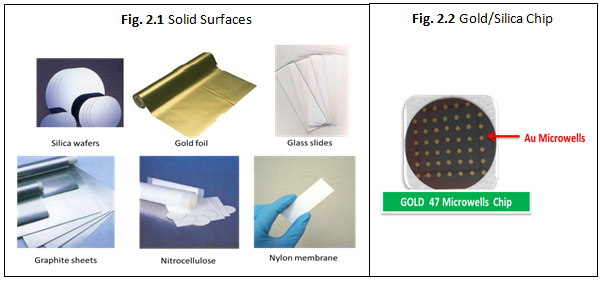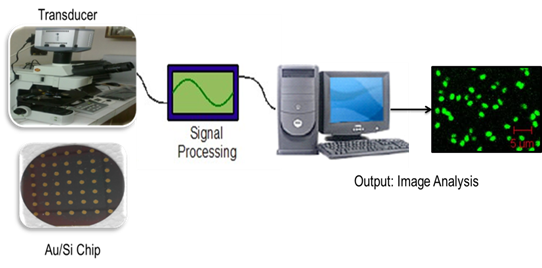The rapid technological advances of the biochemistry and semiconductor fields in the 1980s led to the large-scale development of biochips in the 1990s. Biochips are essentially miniaturized laboratories that are a collection of miniaturized test sites (biorecepters) arranged on a solid substrate that permits many tests to be performed at the same time in order to achieve higher throughput and speed. (Rao et al., 2012). Typically, a biochip's surface area is no larger than a fingernail. Like a computer chip that can perform millions of mathematical operations in one second, a biochip can perform hundreds or thousands of simultaneous biochemical reactions for multianalyte detection. As biochips enable researchers to quickly screen large numbers of biological analytes simultaneously for a variety of purposes, this device is referred to as the multi-functional biochip (Vo Dinh, 2008).
2.0 Components of a Biochip
2.1 Solid substrate or chip surface:
A solid substrate or chip surface is required to immobilize bioreceptors and to carry out biochemical reactions. Silicon wafers, gold foil, glass slides, graphite sheets, nitrocellulose, nylon membranes can be used as solid substrate (Fig. 2.1). Gold/Silica chip can be used as an ideal solid substrate or chip surface.

2.2 Gold/Silica Chip:
Use of Gold/Silica biochips offers several advantages as these are cost-effective and inexpensive biosensing devices. Gold/Silica biochips are employed to reduce the strong quenching in order to enhance the fluorescent signal. Gold/Silica chip with gold microwells as shown in Fig. 2.2 possess the potential of carrying a very less volume of reaction mixture, in order to miniaturize the developed biosensing system, in nanolitres and give detectable signal that can be easily amplified using appropriate tranducer (Mangeat et al., 2008).
2.3 Bioreceptors:
On a biochip DNA, RNA, proteins, and whole living cells or spores can be employed as sensing mediators (Vo-Dinh and Cullum, 2000).
2.4 Transducer:
Biochip technology requires transduction and signal processing technologies to output the results of sensing experiments. Transduction must be done to translate the actual sensing event (DNA binding, oxidation/reduction, etc.) into a format understandable by a computer (voltage, light intensity, mass, etc.), which then enables additional analysis and processing to produce a final, human-readable output. Numerous transduction methods such as surface plasmon resonance, fluorescence, and chemiluminescence can be employed for this purpose. Use of EMCCD as an optical transducer also offers many advantages.

Fig. 2.4.1 Working principle of EMCCD
2.4.1 EMCCD as a Transducer:
EMCCD is Electron Multiplying Charged Coupled Device (Fig. 2.4.1). It is a quantitative digital camera technology that is capable of detecting single photon events whilst maintaining high quantum efficiency, achievable by way of a unique electron multiplying structure built into the sensor. EMCCDs operate by amplifying weak signal events (down to single photons) to a signal level that is well clear of the read noise floor of the camera, at any readout speed.
Further, a particular sensing and transduction techniques chosen depend on factors such as price, sensitivity, and reusability.
3.0 Applications of Biochip Technology
Biochip technology can also be used to rapidly detect, biological pathogens (e.g., bacteria and viruses) present in the environment, at occupational sites such as small clinics and offices, or in public places; Non-microbial contaminants such as pesticides and aflatoxins present in food matrices; Chemical agents used in biological warfare can also be detected so that defensive measures can be taken. Biochip is used in toxicological, protein, and biochemical research. Detection of biochips using nucleic acid probes are often called gene chips, and biochips with antibody probes are often called protein chips.
4.0 Current Status of Biochip Technology
Today, a large no. of biochip technologies are either in the process of development and commercialization. One of the first commercial biochip was introduced by Affymetrix. Their "GeneChip" products contain thousands of individual DNA sensors for use in sensing defects, or single nucleotide polymorphisms (SNPs), in genes such as p53 (a tumor suppressor) and BRCA1 and BRCA2 (related to breast cancer). The chips are produced using microlithography techniques traditionally used to fabricate integrated circuits. Numerous advancements continue to be made in sensing research that enables new platforms to be developed for future applications. Cancer diagnosis through DNA typing is just one market opportunity. In recent times, a no. of industries require methods with detection system that can simultaneously screen a wide range of chemical and biological agents in various matrices, with purposes ranging from testing public water systems for disease agents to screening airline cargo for explosives. All these success stories are indicating the potential of biochip technology for its future application in offering multianalyte detection in broad range of samples collected or isolated from different sources such as food, environment and human.
References:
• Rao, T.V.N., Sai Sukruthi.G, Raj, G. 2012. A Biochip Technology â€"A Gigantic Innovation. Inter. J of Emerg. Technol. and Adv. Eng., 2 (3).
• Vo-Dinh, T. 2008. Multifunctional biochip for medical diagnostics and pathogen detection. Oak Ridge National Laboratory, Oak Ridge U.S.A.
• Mangeat, T., Berthier, A., Elie-Caille, C., Perrin, M., Boireau, W., Pieralli, C., Wacogne, B. 2008. Gold/Silica biochips: applications to Surface Plasmon Resonance and fluorescence quenching.
• Vo-Dinh, T., and Cullum, B. 2000. Biosensors and biochips: advances in biological and medical diagnostics. Fresenius J. Anal. Chem., 366 (6-7).
About Author / Additional Info:
I am pursuing Ph.D. in Dairy Microbiology from ICAR-National Dairy Research Institute, Karnal-132001 (Haryana), INDIA.